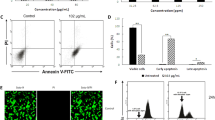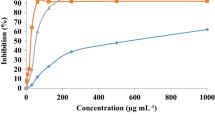Abstract
The effectiveness of chemical drugs has been reduced by the resistance of cancer cells to chemical drugs, such as breast cancer as one of the most common cancers in women. Hence, it is important to study the development of more effective drugs with fewer side effects, such as herbs. Thus, the present study aimed to assess the effects of Moringa oleifera (MO) grown in Iran with anti-cancer properties in the inhibition of apoptosis and proliferation in breast cancer cells. MO extract was prepared in this study while confirming phenolic compounds, namely quercetin, gallic acid, and folic acid, through HPLC methods. Afterward, the apoptotic and anti-proliferative impacts of phenolic compounds were evaluated on 4T1 breast cancer cells via MTT, BrdU, Annexin V-FITC/PI staining, and caspases-9 and -3 activity assays. Furthermore, ELISA was applied to evaluate BAX/Bcl2 ratio. MO extract (0.02, 0.04, and 0.08 g daily for four weeks) was used to treat the BALB/c mice. The size of tumors was measured. MO reduced the proliferation significantly and induced apoptosis (P < 0.01). Furthermore, tumor volume in MO-treated mice was decreased. The reduction in tumor volume at 0.02 g dose was higher than the other two doses (P < 0.001). According to in vitro results, the apoptotic pathway was possibly induced by activating caspases-9 and -3 and an increase in the Bax/Bcl-2 ratio. Through the in vivo results, and significant reduction in tumor size, new evidence was added to the possible treatment of breast tumor provoking intrinsic apoptotic paths.




Similar content being viewed by others
References:
Abdull Razis AF, Ibrahim MD, Kntayya SB (2014) Health benefits of Moringa oleifera. Asian Pac J Cancer Prev 15(20):8571–8576
Al-Asmari AK, Albalawi SM, Athar MT, Khan AQ, Al-Shahrani H, Islam M (2015) Moringa oleifera as an anti-cancer agent against breast and colorectal cancer cell lines. PLoS ONE 10(8):e0135814
Anwar F, Latif S, Ashraf M, Gilani AH (2007) Moringa oleifera: a food plant with multiple medicinal uses. Phytother Res Int J Dev Pharmacol Toxicol Eval Nat Prod Deriv 21(1):17–25
Asgari-Kafrani A, Fazilati M, Nazem H (2020) Hepatoprotective and antioxidant activity of aerial parts of Moringa oleifera in prevention of non-alcoholic fatty liver disease in Wistar rats. S Afr J Bot 129:82–90
Atsukwei D, Eze ED, Adams MD, Adinoyi SS, Ukpabi CN (2014) Hypolipidaemic effect of ethanol leaf extract of Moringa oleifera Lam. in experimentally induced hypercholesterolemic wistar rats. Int J Nutr Food Sci 3(4):355–360
Aung TN, Qu Z, Kortschak RD, Adelson DL (2017) Understanding the effectiveness of natural compound mixtures in cancer through their molecular mode of action. Int J Mol Sci 18(3):656
Baldisserotto A, Buso P, Radice M, Dissette V, Lampronti I, Gambari R et al (2018) Moringa oleifera leaf extracts as multifunctional ingredients for “natural and organic” sunscreens and photoprotective preparations. Molecules 23(3):664
Balogun TA, Buliaminu KD, Chukwudozie OS, Tiamiyu ZA (2020) Anti-cancer potential of Moringa oleifera on BRCA1 gene: systems biology. bioRxiv. https://doi.org/10.1101/2020.12.19.392423
Barez SR, Atar AM, Aghaei M (2020) Mechanism of inositol-requiring enzyme 1-alpha inhibition in endoplasmic reticulum stress and apoptosis in ovarian cancer cells. J Cell Commun Signal 14(4):403
Barez SR, Attar AM, Aghaei M (2021) MicroRNA-30c-2-3p regulates ER stress and induces apoptosis in ovarian cancer cells underlying ER stress. EXCLI J 20:922
Bhattacharya A, Tiwari P, Sahu PK, Kumar S (2018) A review of the phytochemical and pharmacological characteristics of Moringa oleifera. J Pharm Bioallied Sci 10(4):181
Bose CK (2007) Possible role of Moringa oleifera Lam. root in epithelial ovarian cancer. Medscape Gen Med 9(1):26
Cai Y, Luo Q, Sun M, Corke H (2004) Antioxidant activity and phenolic compounds of 112 traditional Chinese medicinal plants associated with anticancer. Life Sci 74(17):2157–2184
Chari RV (2008) Targeted cancer therapy: conferring specificity to cytotoxic drugs. Acc Chem Res 41(1):98–107
Charoensin S (2014) Antioxidant and anticancer activities of Moringa oleifera leaves. J Med Plants Res 8(7):318–325
Chen K-H, Chen Y-J, Yang C-H, Liu K-W, Chang J-L, Pan S-F et al (2012) Attenuation of the extract from Moringa oleifera on monocrotaline-induced pulmonary hypertension in rats. Chin J Physiol 55(1):22–30
Chumark P, Khunawat P, Sanvarinda Y, Phornchirasilp S, Morales NP, Phivthong-Ngam L et al (2008) The in vitro and ex vivo antioxidant properties, hypolipidaemic and antiatherosclerotic activities of water extract of Moringa oleifera Lam. leaves. J Ethnopharmacol 116(3):439–446
Cohen A, Burgos-Aceves MA, Bar-Ziv N, Smith Y (2019) Cruciferous vegetables consumption and lung cancer prevention: Epidemiological studies and molecular mechanisms. J Xiangya Med 4:21
Craig WJ (1997) Phytochemicals: guardians of our health. J Am Diet Assoc 97(10):S199–S204
Fulda S, Debatin K-M (2006) Extrinsic versus intrinsic apoptosis pathways in anticancer chemotherapy. Oncogene 25(34):4798–4811
Gopalakrishnan L, Doriya K, Kumar DS (2016) Moringa oleifera: a review on nutritive importance and its medicinal application. Food Sci Hum Wellness 5(2):49–56
Gordaliza M (2007) Natural products as leads to anticancer drugs. Clin Transl Oncol 9(12):767–776
Gupta R, Mathur M, Bajaj VK, Katariya P, Yadav S, Kamal R, Gupta RS (2012) Evaluation of antidiabetic and antioxidant activity of Moringa oleifera in experimental diabetes. J Diabetes 4(2):164–171
Jung IL (2014) Soluble extract from Moringa oleifera leaves with a new anticancer activity. PLoS ONE 9(4):e95492
Khor KZ, Lim V, Moses EJ, Abdul Samad N (2018) The in vitro and in vivo anticancer properties of Moringa oleifera. Evid Based Complement Altern Med
Korsor M, Ntahonshikira C, Bello HM, Kwaambwa HM (2019) Growth performance of Moringa oleifera and Moringa ovalifolia in central namibia semi-arid rangeland environment. Agric Sci 10(02):131
Kou X, Li B, Olayanju JB, Drake JM, Chen N (2018) Nutraceutical or pharmacological potential of Moringa oleifera Lam. Nutrients 10(3):343
Krishnamurthy PT, Vardarajalu A, Wadhwani A, Patel V (2015) Identification and characterization of a potent anticancer fraction from the leaf extracts of Moringa oleifera L.
Lopez-Rodriguez NA, Gaytán-Martínez M, de la Luz Reyes-Vega M, Loarca-Piña G (2020) Glucosinolates and isothiocyanates from moringa oleifera: chemical and biological approaches. Plant Foods Hum Nutr 25:1–11
Milugo T, Omosa L, Owuor B, Oyugi J, Ochanda J, Wamunyokoli F. Anti-cancer activities of crude extracts from kenyan Moringa oleifera Lam and Rauwolfia caffra against selected cancer cell lines
Mohan M, Maatman TC, Schinke C (2021) The role of monoclonal antibodies in the era of bi-specifics antibodies and CAR T cell therapy in multiple myeloma. Cancers 13(19):4909
Mohd Fisall UF, Ismail NZ, Adebayo IA, Arsad H (2021) Dichloromethane fraction of Moringa oleifera leaf methanolic extract selectively inhibits breast cancer cells (MCF7) by induction of apoptosis via upregulation of Bax, p53 and caspase 8 expressions. Mol Biol Rep 48(5):4465–4475
Nair S, Varalakshmi K (2011) Anticancer, cytotoxic potential of Moringa oleifera extracts on HeLa cell line. J Nat Pharm 2(3):138–142
Nigjeh SE, Yeap SK, Nordin N, Rahman H, Rosli R (2019) In vivo anti-tumor effects of citral on 4T1 breast cancer cells via induction of apoptosis and downregulation of aldehyde dehydrogenase activity. Molecules 24(18):3241
Onah IA, Onukwube GI, Odoh CE, Odimegwu DC (2017) Moringa oleifera, an adjuvant for respiratory snycytial virus vaccine. Aust J Basic Appl Sci 11(12):95–101
Pangastuti, A., Amin, I. F., Amin, A. Z., & Amin, M. (2016). Natural bioactive compound from Moringa oleiferaagainst cancer based on in silico screening. J Teknol 78(5)
Parvathy MVS, Umamaheshwari A (2007) Cytotoxic effect of Moringa oleifera leaf extracts on human multiple myeloma cell lines. Trends Med Res 2:44–50
Peter A, Walter A, Wagai S, Joseph O (2011) Antibacterial activity of Moringa oleifera and Moringa stenopetala methanol and n-hexane seed extracts on bacteria implicated in water borne diseases
Poussel M, Penven E, Richard C, Mercy M, Chabot F, Paris C (2015) Occupational asthma to “the miracle tree” (Moringa oleifera): first description. European Respiratory Society, New York
Purwal L, Pathak A, Jain U (2010) In vivo anticancer activity of the leaves and fruits of Moringa oleifera on mouse melanoma. Pharmacologyonline 1:655–665
Randriamboavonjy JI, Loirand G, Vaillant N, Lauzier B, Derbré S, Michalet S et al (2016) Cardiac protective effects of Moringa oleifera seeds in spontaneous hypertensive rats. Am J Hypertens 29(7):873–881
Ribeiro ADA, Nardocci AC (2013) Socioeconomic inequalities in cancer incidence and mortality: review of ecological studies, 1998–2008. Saude e Sociedade 22:878–891
Sánchez-Machado DI, Núñez-Gastélum JA, Reyes-Moreno C, Ramírez-Wong B, López-Cervantes J (2010) Nutritional quality of edible parts of Moringa oleifera. Food Anal Methods 3:175–180
Santos AF, Argolo AC, Paiva PM, Coelho LC (2012) Antioxidant activity of Moringa oleifera tissue extracts. Phytother Res 26(9):1366–1370
Song Y-H, Sun H, Zhang A-H, Yan G-L, Han Y, Wang X-J (2014) Plant-derived natural products as leads to anti-cancer drugs. J Med Plant Herb Ther Res 2:6–15
Sreelatha S, Padma P (2009) Antioxidant activity and total phenolic content of Moringa oleifera leaves in two stages of maturity. Plant Foods Hum Nutr 64(4):303–311
Sreelatha S, Jeyachitra A, Padma P (2011) Antiproliferation and induction of apoptosis by Moringa oleifera leaf extract on human cancer cells. Food Chem Toxicol 49(6):1270–1275
Sun W, Shahrajabian MH, Cheng Q (2020) Traditional Iranian and Arabic herbal medicines as natural anti-cancer drugs. Agrociencia 54(1):129–142
Tiloke C, Anand K, Gengan RM, Chuturgoon AA (2018) Moringa oleifera and their phytonanoparticles: potential antiproliferative agents against cancer. Biomed Pharmacother 108:457–466
van Rijt SH, Sadler PJ (2009) Current applications and future potential for bioinorganic chemistry in the development of anticancer drugs. Drug Discov Today 14(23–24):1089–1097
Waks AG, Winer EP (2019) Breast cancer treatment: a review. JAMA 321(3):288–300
Wang J, Jiang Y-F (2012) Natural compounds as anticancer agents: experimental evidence. World J Exp Med 2(3):45
Winston C, Beck L (1999) Phytochemicals: health protective effects. Can J Diet Pract Res 60(2):78
Zalpoor H, Nabi-Afjadi M, Forghaniesfidvajani R, Tavakol C, Farahighasreaboonasr F, Pakizeh F et al (2022b) Quercetin as a JAK–STAT inhibitor: a potential role in solid tumors and neurodegenerative diseases. Cell Mol Biol Lett 27(1):1–17
Zalpoor H, Bakhtiyari M, Liaghat M, Nabi‐Afjadi M, Ganjalikhani‐Hakemi M (2022a) Quercetin potential effects against SARS‐CoV‐2 infection and COVID‐19‐associated cancer progression by inhibiting mTOR and hypoxia‐inducible factor‐1α (HIF‐1α). Phytother Res
Zunica ER, Yang S, Coulter A, White C, Kirwan JP, Gilmore LA (2021) Moringa oleifera seed extract concomitantly supplemented with chemotherapy worsens tumor progression in mice with triple negative breast cancer and obesity. Nutrients 13(9):2923
Acknowledgements
The authors are gratefully acknowledging from research council of Falavarjan Branch, Islamic Azad University.
Funding
The authors have not disclosed any funding.
Author information
Authors and Affiliations
Corresponding author
Ethics declarations
Conflict of interest
There are no conflicts of interest.
Supplementary Information
Below is the link to the electronic supplementary material.
Rights and permissions
Springer Nature or its licensor (e.g. a society or other partner) holds exclusive rights to this article under a publishing agreement with the author(s) or other rightsholder(s); author self-archiving of the accepted manuscript version of this article is solely governed by the terms of such publishing agreement and applicable law.
About this article
Cite this article
Yousefirad, A., Rastegari, A.A., Shahanipour, K. et al. Evaluation of Proliferative Inhibition Effect of Moringa oleifera Total Extract on Breast Cancer: An In Vitro and In Vivo Study. Iran J Sci 47, 653–662 (2023). https://doi.org/10.1007/s40995-023-01434-6
Received:
Accepted:
Published:
Issue Date:
DOI: https://doi.org/10.1007/s40995-023-01434-6




